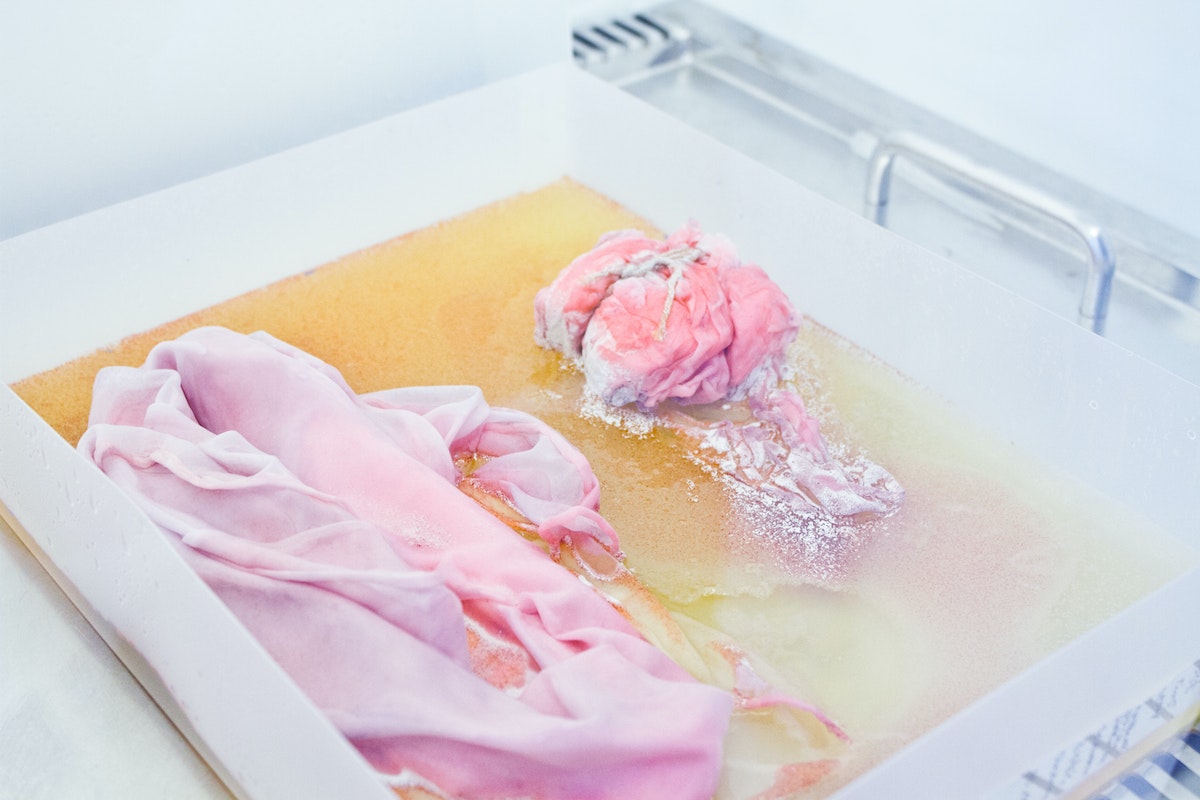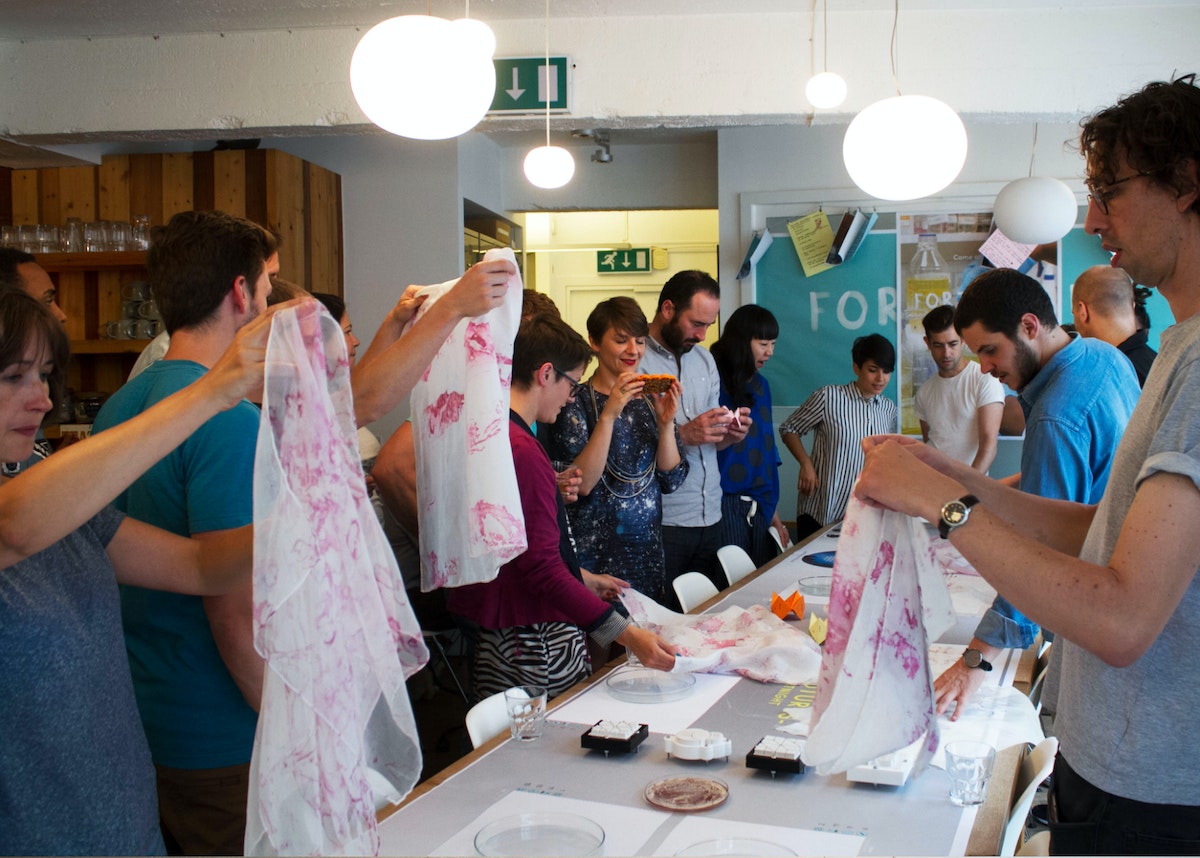The Beautiful Future of Living Technology

Vivid pinks, blues, greens and yellows form beautiful, organic abstract shapes on Natsai Audrey’s delicate silk scarves. But they’re not drawn by her, or silkscreened in a print studio. Instead, the shapes are the life and death of streptomyces bacteria writ colorful on silk, folded into a petri dish, in a lab.
Zimbabwe-born Natsai studied architecture at Edinburgh University, then at Central St. Martin’s Material Futures course. There she learned about synthetic biology, and met Dr. John Ward, a professor from UCL’s microbial molecular biology lab. He became a supporter of her scarf project, called Fold.

Natsai is at the forefront of an emerging field, biodesign, that aims to tackle the climate change problems caused by textiles and farming. Fueled by advances like the gene editing technique CRISPR, which is making designing with DNA simpler and cheaper, scientists and designers are looking to harnessing nature itself to ‘biofacture’ everything from leather, to meat, to medicine.
Companies like Bolt Threads are spinning synthetic spider silk, while Modern Meadow is growing meat in labs. Meanwhile Autodesk is creating design tools for the field—think AutoCAD for DNA.

Natsai joined IDEO’s London studio as part of our two week-long Fortnight residency, collaborated with the community here, and shared the resulting scarves. As part of her final presentation, she brought to life the potential of biodesign with a series of five tweets. Here, she explains the speculative future they’re framed in. It is a future in which synthetic biology is shaping brands, products, businesses, and people’s behavior.
Future Craft
“Hyper-specialized hybrid technologies signal the rise of the niche maker. #DIYbio #biomakerspace”
Natsai: I’m really interested in the dialogue between craft and technology. This tweet depicts my own reality: my craft is so specialized that I have to design the tools to create it, and I also have had to learn how to maintain the life that co-creates it, without any precedents to learn from. Imagine a world where our materials are alive or derived from living systems. Every maker will intimately know the biochemistry of their chosen species, and will find new ways of transforming those organisms’ behaviors into truly unique products and processes. We’ll be using other living systems and even amalgamating layers of digital technology to biofabricate.

Service Design
“Who owns your wardrobe? #panasonic4nike”
Natsai: I had a conversation with a colleague about how one might go about democratizing the production of ‘bio-factured’ products. At the time I was thinking about how to streamline the process for scaling up this technology, but he challenged me to think about new models of distribution that tap into DIY culture. Ultimately, his question was: if you can grow your own textiles, then who owns your wardrobe? The hashtag #Panasonic4Nike points towards a future that sees unlikely stakeholders coming together to offer true innovations in designing the products we use, as well as the services and hardware that enable us to do this in a personalized way.
Convergence
“Digitized biology has democratized the creation of complex biological consumer products. #autodesk #synbio #AI #IOT”
Natsai: I understand that not only do I work with a pigment-producing bacteria, but that medium is also a biological sensor. Producing pigment signals a crucial stage in the bacteria’s life cycle. This made me ask: how could we harness living sensors and build them into our everyday environments? The notion of technology convergence is definitely something I see happening further into the future. Wearable technology, household electronics and the Internet of Things, in my view, will expand and come together to create mutually-beneficial ecosystems of bacteria and digital technology.

Metabolic Materiality
“Biofacturing process & biological characteristics of an organism now define a brand’s identity and its business model. #bottomupprimacy #IP”
Working in a fashion context, I am hyper aware of how a brand’s identity communicates. The product itself needs to hold true to the values of the brand. This is the part that gets tricky working with a living technology: at some point I relinquish control to my bacterial colonies to finish the garments—conceptually speaking, I provide the structural parameters. The lack of control is a challenge and an opportunity to design interventions that end up in line with the brand identity. Creativity therefore becomes crucial, to push the aesthetics and craft processes in the development of each garment. Although it’s true of any industry, fashion is a particularly interesting space to consider a business model based on that uniqueness. Even before we think about synthetic biology as a way of manufacturing, designers can and should push innovation beyond a simple “genetically-modified organism 1 fixes problem A.”
Beyond Monoculture
“Happy Kombucha shares rally as merger with Kvadrat announced. #symbioticventures #closedloopsystem”
This really looks at future business models and ecosystems of information and skill exchange. Happy Kombucha actually exists and it’s my go-to for food and beverage bacterial cultures in the UK. They mainly sell starters and toolkits for brewing your own kombucha, kefir water and kefir milk. This tweet is a little tongue-in-cheek: it imagines that their business strategy has evolved to sell the SCOBYs (the symbiotic colony of bacteria and yeast that ferments tea, to make kombucha) as fabrics, leading to a merger with major textile manufacturing brand Kvadrat. It also speaks of the current and future reality of the trade of living organisms.
IDEO Fortnight with Natsai Audrey Chieza from Alexandra Whiting on Vimeo.
Words and art

Subscribe

.svg)







